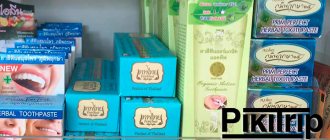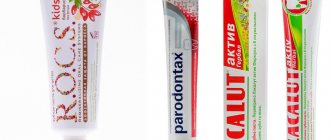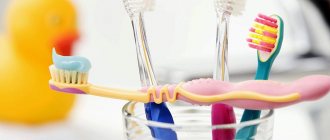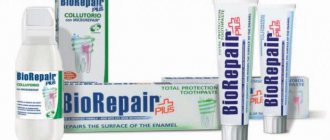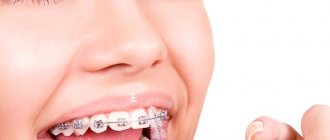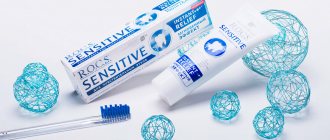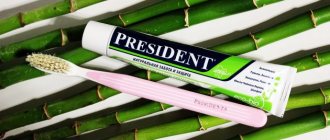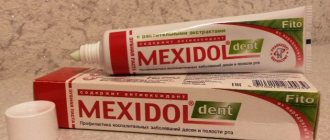What do you need to know?
Many people believe that to maintain healthy teeth it is enough to purchase a special toothpaste.
But in reality, everything is not so, because it is important to take into account some nuances:
- paste against tartar and plaque will not help if everything is already mineralized;
- Pastes only work in combination, without special nutrition and proper brushing techniques, it will not be possible to completely protect your teeth and make them healthier;
- the paste will only work if used regularly - at least twice a day;
- a hygiene product should be selected based on individual characteristics, without relying on reviews of other consumers;
- People with healthy teeth should not use such pastes regularly, but in courses - several times a year.
You won't be able to get rid of hard deposits with paste.
Splat toothpaste – varieties and beneficial properties
The well-known Russian company produces popular and high-quality oral care products.
The company has been operating since the early 90s of the 20th century. At first, toothpastes of this brand were used as medicinal products; many became acquainted with them on the recommendation of dentists. But now Splat products are becoming increasingly popular. Toothpastes of this brand help maintain healthy teeth and gums. In addition, they have a pleasant taste and do not contain harmful synthetic components. Therefore, all pastes are completely safe for health. A wide variety of assortments allows everyone to choose a dental care product to their liking. The Splat Professional series is especially popular.
These toothpastes have therapeutic and prophylactic properties. Each of them contains components that have a specific effect: they heal gums, strengthen enamel, and reduce sensitivity. Particularly popular is the Splat Biocalcium paste, reviews of which note that it is effective for preventing caries and strengthening tooth enamel.
The Russian market produces four independent series of toothpastes under the Splat brand.
- Professional - each toothpaste from the presented series is aimed at solving a specific dental problem. The use of such products for the prevention of dental and oral diseases will help you forget about visits to the clinic for a long time. Often, dentists themselves recommend using toothpastes from this series as an additional remedy to the main treatment.
- Special - all pastes in this series contain a certain unique component. This confirms the information that Splat Special products are one of a kind.
- Absolutely safe toothpastes from the children's series can be used by children from birth. They will ensure healthy teeth growth, gum protection, and strengthening of enamel. The bright design of the tube and a wide range of flavors allow you to choose the right toothpaste for each child.
- Effective complex Splat toothpastes can now be taken on the go in a mini format. Tubes with a volume of 40 ml each look compact and take up virtually no space in your travel bag. This series includes 5 types of toothpastes.
The Splat toothpaste collections contain products for solving various dental problems. All of them are created with concern for environmental cleanliness and customer health. Modern Splat toothpastes have a bright design, original names, and a proven effect. They are available in volumes of 40 ml (travel mini format), 75 ml, 100 ml.
In addition to toothpastes, the Splat brand produces dental floss and complete travel kits. A unique product is foam, which can be used when brushing your teeth is not possible. Their convenient format and variety of flavors make them a popular product that is beneficial for oral health.
The manufacturer offers customers 3 lines of pastes: Professional (includes 11 types of pastes), Special (consists of 14 varieties), products for children. Let's take a closer look at each product series and the composition of Splat toothpastes.
PROFESSIONAL
The line of products provides comprehensive oral care. It is recommended to use Professional series gels in case of exacerbation of dental diseases or in the presence of chronic pathologies in the oral cavity. Pastes in this series will reduce the number of visits to the dentist. You can use the product several times a day without harm to the enamel and mucous membranes.
Professional series pastes.
The Splat toothpaste range is represented by two main series – Professional and Special. The first includes products aimed at solving specific dental problems: gentle care for inflamed gums, strengthening, restoration and protection of teeth from tartar and caries, whitening enamel. For the production of Special series products, environmentally friendly raw materials are used.
We invite you to familiarize yourself with No-Shpa: composition, dosage, contraindications
The Professional Splat series includes the following toothpastes:
- "Assets". The toothpaste has an unusual black color, which is given to it by plant extracts. It has a strong hemostatic and anti-inflammatory effect. Contains antioxidants - vitamins A and E, as well as a source of calcium ions - calcium glycerophosphate, which promotes the remineralization of tooth enamel.
- "Healing herbs". Gel paste based on medicinal herbs and geranium essential oil. Can be used to prevent bleeding gums and stomatitis - inflammation of the oral mucosa. Contains calcis, a substance obtained from eggshells that strengthens enamel. As well as vitamins A, C, E (antioxidants) and geranium oil, which has antiseptic properties.
- "Lavandasept." Provides powerful antibacterial protection for gums and prevents the occurrence of dental diseases thanks to the content of essential oils of lavender, thyme and rosemary. Prevents the development of stomatitis, gingivitis and periodontitis. The inclusion of papain in the product with Dissolvine whitening salts ensures gentle lightening of tooth enamel.
- "Biocalcium". Contains components such as biocalcis and hydroxyapatite - a building material for dental tissue. Thanks to this composition, after several days of using Splat “Biocalcium”, tooth sensitivity decreases and the enamel layer of the teeth becomes denser.
Special Series Splat
Among the most popular Special series pastes are the following:
- Blackwood. Thanks to juniper berry extract, a complex of active substances and antiseptics, Biosol protects teeth from bacteria and plaque formation. Thanks to the content of Karelian birch charcoal, a powerful whitening effect is achieved and bad breath is neutralized. In addition, it gives the toothpaste the same shiny black color as Splat Professional “Active”. The products are recognizable by the pronounced smell of juniper.
- Shock. Nettle extract, vitamins K and C, Kayaput oil, which are part of Splat Special Shock, have a strong antimicrobial and hemostatic effect. Nettle extract gives the paste a burning taste, which enhances blood microcirculation through the capillaries in the oral cavity.
- Chili. Contains hot chili pepper extract, which improves blood circulation in gum tissue, and capsaicin (a substance found in chili peppers), which has a powerful immunostimulating effect. Thanks to the soft silicon base, the product effectively brightens enamel.
Splat toothpastes for children are produced in separate series under the names Baby, Kids, Junior. Each series is intended for children of a certain age.
Main types of Splat children's toothpastes:
- Baby “Vanilla” (from 0 to 3 years). Protects enamel from caries and helps reduce gum pain during teething. Safe if swallowed.
- Kids "Milk chocolate" (from 2 to 6 years). The innovative Luctatol system based on licorice and lactic enzymes destroys carious bacteria and prevents their further development.
- Junior “Bubble Gum” (from 6 to 11 years old). Fights carious bacteria. Thanks to the content of extracts of magnolia bark, pomegranate, cranberry, it has an anti-inflammatory effect.
Splat children's toothpastes contain lactic enzymes that protect temporary teeth from harmful external influences. In addition, they contain licorice extracts, hydroxyapatite, casein and calcis - substances that protect teeth from caries, cleanse enamel, reduce gum bleeding and promote the formation of tooth enamel.
Types of soft deposits
Most bacteria are acid-forming, which is the main factor in the destruction of enamel. Gradually, the thickness of the bacterial layer increases, reaching 60-70% of the entire thickness of the plaque.
Reference. Lengthy discussions among specialists about which bacteria are the most cariogenic ended with the primacy being given to Str. Mutans. This type of microorganism produces organic acids that demineralize tooth enamel and dentin, causing caries.
Plaque accumulates on all surfaces of teeth, but most of it is formed in fissures, in the cervical area and on exposed roots. The softer the food taken, and the more sucrose it contains, the more intense the plaque is formed. Oral fluid partially washes away plaque, but cannot completely cope with it. Human intervention is required in the form of repeated daily cleaning.
The color of dental plaque is predominantly light. But sometimes, depending on the food you eat and lifestyle, the plaque can take on other color shades. By the shade you can determine the cause of its appearance and the most effective way to get rid of it:
- Yellow, orange or brick-red plaque usually appears in children in the cervical area of the incisors. The reason for its appearance is special chromogenic bacteria localized in dental plaque. If teeth are brushed regularly, it will not form. But in advanced cases, only professional cleaning can deal with it.
- White plaque is soft and harmless, although it can accumulate in significant quantities. Easy to clean with a brush and paste. Rinsing removes only partially. A certain amount is also removed when eating. Remains mainly in the interdental spaces and cervical areas. Despite the relative ease of its removal, if stored for a long time, like other types, it transforms into tartar.
- Brown deposits most often appear in people who smoke. Excessive consumption of tea or coffee can also lead to them. In heavy smokers, plaque eats deep into the enamel, forming a dark brown film that is difficult to remove. To prevent this from occurring, smokers are advised to use highly abrasive toothpaste. But it doesn’t always help either. Only professional abrasive cleaning methods, such as Air Flow, can cope with it.
- Black plaque appears as a black or dark brown “ribbon” on the cervical area near the gingival margin. Most often, it is a consequence of the ability of the individual organism to produce mucinous plaque, in which chromosomal bacteria are localized. Women encounter it more often than men. The intensity of staining increases with poor oral care, smoking, and consumption of staining foods.
Experts attribute the following factors to the main causes of the problem:
- Incorrect or irregular hygiene procedures;
- Having bad habits, especially smoking;
- Presence of systemic diseases;
- Unbalanced diet with a predominance of carbohydrates and sucrose;
- Use of unsuitable or poor quality hygiene products;
- Long-term use of the same brush;
- Individual characteristics of the patient’s body;
- Improper chewing of food;
- Malocclusion.
Product advantages
The wrong choice of oral care products not only provokes an exacerbation of chronic dental disorders, but also creates new problems. Therefore, you need to be especially careful when choosing toothpastes and brushes for dental care.
Splat toothpastes have a wide range, thanks to which every patient can find a suitable product for themselves. The low cost of the drug is due to the lack of commercial advertising. The buyer will be able to learn about the company's new developments and the range of products provided from the brochure included in the paste packaging.
Dentists also note the positive effects of the components of the product on the oral cavity and the minimal risk of developing side effects from their use. Companies present products with both single and complex spectrum of action.
We invite you to read: How to deal with lost baby teeth: throw them away, keep them, or give them to a fairy?
The advantages of the product include:
- possibility of daily use;
- reasonable price;
- maintaining fresh breath for a long time;
- effective removal of tartar;
- lightening the enamel by several tones.
The difference between this product is the absence of additives such as chlorhexidine, triclosan, which can be used in pastes.
It has been clinically proven that after four weeks of use, it showed high hemostatic ability in 50.2% of cases, lightened the enamel by 1.5 tones, and its remineralizing efficiency was about 40%.
The mass fraction of fluoride ions is 0.1% (1000 ppm), therefore, if you consume fluoride from any other sources (for example, tap water with a high content), the manufacturer recommends consulting a dentist.
Anti-tartar toothpaste: rating of the best abrasives
Tartar is the result of long-term accumulation of plaque on the surface of the teeth. Depending on the location, it can be subgingival or supragingival. It is not only an aesthetic drawback, but also causes serious harm to oral health. After all, it is tartar, obtained as a result of poor hygiene, that becomes the cause of gingivitis and periodontal disease.
These diseases not only cause a lot of inconvenience, but can also lead to complete loss of teeth. To cope with the problem, you need to resort to professional cleaning and use special pastes for everyday hygiene. Next, we will tell you how to choose the right anti-tartar paste and what they are.
We suggest you read What to do if the lymph nodes in the neck are inflamed
Reviews of Thai toothpastes
Reviews of toothpastes from Thailand from real customers can be read on the page of each product. Here are just a few of them, collected at the end of the article:
“I received this paste as a gift. At first the packaging seemed small! BUT! It is so economical that in principle there is no need for more. A very good option for travel. Both my husband and I liked it, although he is picky about toothpastes. The best pastas are from Thailand; ours cannot be compared.”
“Great pasta!!!! I'm used to it and I only read to it!!!! At first the taste was unusual, but then I got used to it. And the teeth remain clean and smooth and there is no hint of plaque during the day!!!! I got my relatives hooked on this paste, everyone is happy!!! Some people smoke and the paste helps whiten and improve gums and teeth.”
“Favorite toothpaste! Cleanses very well, leaves you feeling fresh all day, reduces sensitivity. I have been using the paste for over a year now, since then my throat has stopped hurting, before that I almost always had inflamed tonsils. Pleasant slightly herbal taste, there is no terrible taste of menthol and flavorings as in Russian pastes and there is no huge amount of foam. Big tube."
“This is the second year the whole family has been using exclusively Thai pastes (we’ve probably already tried them all!). The review is great! Naturally, from all the variety of Thai pastes, we have already identified our favorite ones. This herbal one is also one of the most beloved and constantly purchased.”
If you need Thai toothpaste, the BestFromThai online store will always provide you with a wide selection of quality toothpastes from Thailand. Knowing where to buy Thai toothpaste, you can also see what users think about a particular product - we only have real reviews. Thai toothpaste can also be purchased wholesale with our help - we have a “Joint Purchases” section, and every month dozens of our partners buy all products at discounts, doing business with us.
Thai pastes are a solution to the problem of teeth whitening, caries prevention, removal of plaque and tartar without going to the dentist. The right product and its careful use will ensure oral health for a long time. If you don’t know which toothpaste is best for brushing your teeth, you can consult our consultants. They are always happy to help and give professional advice.
*The information on our website is translated from Thai by resources that collaborate with doctors and specialists to provide reliable information. However, the content on this site is intended for additional, general educational information only.
The materials on the site are not intended for diagnosis or self-medication in any way and do not replace qualified medical examination and diagnosis. If you have illness or discomfort, consult your doctor. We are against self-medication, we are for a reasonable approach to healing.
How to treat stone on teeth
In order to remove tartar, you will have to visit the dentist's office. There are cases when you can deal with the stone yourself, but this is only possible at the initial stage of plaque crystallization. For home stone removal, home medicine methods and all kinds of toothpastes are used.
It is worth noting that any anti-tartar toothpaste can only cope with soft deposits on the teeth. Hard plaque can only be removed in a dental office.
In order to remove tartar, dentistry used to use all kinds of instruments. Most of them were handmade in the form of special hooks and hammers. This made the stone removal procedure very painful and unaccepted. Currently, such techniques are no longer used anywhere. Modern methods of cleaning teeth have been invented, which are fast, automated and painless for the patient.
Removing plaque and tartar from teeth using alternative methods
There are several alternative methods for removing plaque in dentistry, which include:
- To remove stone, you will need a special scanner that allows you to eliminate even those deposits that are hidden under the gums. The mechanical method using a bur is used in dental offices. The dentist, having plucked the crystallized accumulation with a special bur, begins to scrape the surface.
- Ultrasonic method. To remove stone, you will need a special scanner that allows you to eliminate even those deposits that are hidden under the gums.
- The laser method makes it possible to remove plaque layer by layer. The stones are crushed into small particles and removed from the oral cavity with jets of air and water.
- A chemical method using a special paste, gel, which contains acid and alkali. The active components of a special chemical agent help soften (dissolve) the stone and easily remove it from the enamel surface.
How to remove tartar using ultrasound and toothpaste?
Many people are interested in the question of whether it is painful to remove tartar at the dentist. It all depends on the method used for removal. Several years ago, almost every dentist had ultrasonic devices in their office that make it possible to remove hard mineralized formations.
How to remove tartar using ultrasound and toothpaste:
- The operating principle of the device is based on the supply of special ultrasonic waves, which destroy the structure of solid formations and help eliminate them. This manipulation allows you to whiten your teeth, make them beautiful and neat.
- Remember that ultrasonic cleaning is very effective among smokers, as it helps remove plaque that accumulates over several years. Many patients are interested in the question, is the procedure painful? In fact, it all depends on the sensitivity of the teeth.
- If the teeth are very sensitive, and tartar has grown, there is a large amount of it in the mouth, it penetrates into the gum pockets, then it is recommended to perform anesthesia. Unlike mechanical cleaning, the ultrasonic method of getting rid of tartar is more gentle and does not damage the enamel. After the procedure, many dentists recommend fluoridation of teeth.
- This is due to the fact that in the process of exposure of teeth to ultrasound, the stone is destroyed, but the enamel becomes porous. Accordingly, it is susceptible to various kinds of destroyers, and can be colored with the help of coffee or some natural juices. That is why do not refuse fluoridation after ultrasonic cleaning.
- Previously, tartar was removed using special means and mechanical action. Simply put, he was scraping off the walls. As patients noted, the procedure was quite painful, because the instrument could get into the gum and cause severe pain.
After such exposure, the enamel is very weakened and prone to plaque accumulation, and the occurrence of tartar increases. Accordingly, new foci of mineralized hard formations very quickly form on cleaned teeth mechanically. The use of ultrasound improves the situation and not only helps remove tartar, but also prevents the formation of new hard areas.
Treatment
How to remove and get rid of tartar at home?
- Remember that the best treatment is prevention. Brush your teeth thoroughly morning and evening, paying attention to hard-to-reach areas. Choose a toothbrush with a small head so that it can reach the back teeth. In order for the brush to remove plaque, the bristles should not be too soft. Remember that plaque appears a couple of hours after eating. Floss and rinse with warm water
- Visit your dentist regularly. Some types of tartar are not visible at first glance. A specialist will be able to identify the problem in time
- At least once a week, use toothpaste with solid microparticles that thoroughly remove plaque. You can prepare this paste at home. Add a pinch of baking soda and a drop of lemon juice to your daily paste. Another recipe is to crush an activated carbon tablet and add it to regular paste. Don't be confused by the black color; when rinsed it will disappear without a trace.
- If the plaque is already old, try treating it chemically. Plaque has an alkaline environment, and acids can eliminate it. Make a special solution: 2 drops of lemon juice, 5 drops of peroxide and a little baking soda. Apply this mixture to plaque accumulation areas and leave for several minutes. Then brush your teeth and rinse your mouth thoroughly
- Solid foods can naturally remove plaque. Eat apples, carrots, beets. Just do not cut the vegetables, but bite them yourself and chew thoroughly
Eating solid foods reduces the risk of developing tartar.
Differences from stone
Plaque must be distinguished from tartar. It consists of food debris, epithelial cells, leukocytes, fungi and various microorganisms, both harmful and not so harmful. The number of types of the latter is very large, can reach 1000. Tartar is formed from plaque as a result of its impregnation with mineral components and subsequent hardening. In addition to food debris, dead cells and bacteria, it contains solid salts of iron, phosphorus and calcium.
The process of their formation takes time. Promotes the formation of tartar and disrupts human salt metabolism. A stone differs from a plaque in a number of ways:
- Color. The plaque is usually colorless or pale yellow. Dental supragingival calculus is predominantly white and yellow-white, subgingival calculus is dark brown, greenish, and black.
- Composition. As already noted, in addition to organic deposits, tartar contains inorganic deposits - calcium, phosphorus and iron salts.
- Density. The plaque is soft, the stone, especially subgingival, is hard.
- Strength of adhesion to enamel. Tartar adheres firmly to the enamel and cannot be removed even by the most intensive brushing of teeth. The connection between plaque and enamel is small; in most cases, it is relatively easily removed by regular cleaning. Only in some cases, professional cleaning is required to remove old plaque.
- Clinical symptoms. The plaque does not manifest itself with any negative consequences, except perhaps aesthetic ones. Tartar can be accompanied by itching and bleeding gums.
We invite you to familiarize yourself with Transparent and white blisters on the mucous membrane of the mouth: treatment and symptoms of dermatoses
Why does tartar form?
The main reason for the formation of tartar is insufficient oral hygiene. If you brush your teeth irregularly, spend less than 2 minutes on this activity, and do it not thoroughly enough, microbial plaque will form on your teeth. Especially often, stone forms between the teeth, since this is where they are not cleaned thoroughly enough.
An incorrectly selected toothbrush and unsuitable toothpaste also contribute to the formation of tartar. Tartar itself is hardened plaque that has not been cleaned off for a long time (4-6 months) and has been exposed to various minerals. Over time, these deposits harden, causing discomfort and causing various inflammatory diseases of the teeth and gums.
What is tartar, why is it formed and why is it dangerous?
Tartar is hardened plaque that, under the influence of saliva, turns into dense deposits.
The mechanism by which the pathology occurs is that even with high-quality cleaning of the teeth and interdental space, microscopic areas of plaque that form after eating can remain in hard-to-reach places. It is soft at first and can be easily removed by yourself.
Subsequently, the amount of plaque increases, it begins to gradually harden under the influence of salts contained in human saliva. All this leads to the growth of hardened plaque, which can gradually begin to expose the roots of the teeth, creating peculiar “pockets” on the gums.
Tartar is porous in structure and is an excellent place for bacteria to grow. In addition, under the plaque, the enamel gradually thins and begins to crack. All this leads to the appearance of dental diseases, which in severe cases can lead to tooth loss.
In advanced cases, tartar can affect a significant area of the oral cavity, leading to increased tooth sensitivity and bad breath.
All this leads to an increased risk of numerous oral pathologies. In addition, it looks unaesthetic, which can cause psychological discomfort to the patient. Therefore, you should monitor the condition of your teeth and promptly remove hardened deposits.
Preparations with silver
Tartar is effectively removed by silver paste. The most popular are Sensitive and Silver. The first option is ideal for sensitive teeth. It cleanses them, eliminates pathogenic bacteria and prevents stone formation. If you use this paste constantly, then in addition to cleaning the enamel, you will be able to reduce bleeding gums. Silver has an antibacterial effect, destroys pathogenic microorganisms and improves blood circulation in the gums.
Silver toothpaste has a similar property. With regular use, it will be possible to remove hard deposits and protect the gums from the negative effects of pathogenic bacteria. Daily use of this product whitens the enamel and eliminates unpleasant odors. Fans of coloring drinks and cigarettes should pay attention to Silver.
Prevention of tartar
A number of preventive rules will allow you to reduce the amount of food deposits on your teeth:
- Regular hygiene procedures. It is not enough to brush your teeth 2 times a day; it is important to know about the rules of dental care: hold the brush at an angle of 45 degrees, continue brushing for 2-3 minutes, you need to clean your wisdom teeth and tongue especially carefully (the majority of bacteria accumulate in these areas).
- Correct selection of toothpastes for removing tartar. Preference is given to brushes with medium-hard bristles (if there are no dental diseases).
- Use of additional devices: threads, mouth rinses, irrigators.
- Rinse your mouth with water or solutions after each meal. If this procedure is not possible, it is recommended to use chewing gum.
- Regular visits to dental clinics.
Toothpastes can only remove light to moderate hardened plaque. Medicines are powerless against old tartar. In these cases, the patient will need the help of a dentist.
Features of the composition of preparations for plaque removal
When choosing hygiene products, you need to pay attention not only to the manufacturer’s promises, but also independently analyze the components present in the recipe. We list the most common ones:
- Triclosan. The active substance helps cope with the accompanying symptoms of dental disease. It has an antibacterial effect, which means it neutralizes pathogenic microflora and relieves signs of inflammation. Such compositions should be used only in the first period of treatment, when it is necessary to relieve bleeding and inflammation. Its constant use leads to disruption of the natural flora.
- Calcium carbonate. Performs the function of an abrasive. Its amount in the formula determines the abrasiveness index of the drug. The higher the indicator, the faster you can get rid of tartar. But intensive use of aggressive agents leads to damage to the enamel surface. For people with hypersensitivity, it is better to limit themselves to products with an abrasiveness no higher than 25 RDA.
- Fluorine. Added to restore calcium in the hard tissues of the tooth. During intensive treatment, the mineral composition of the enamel is inevitably damaged. If you do not replenish it with calcium, there is a high risk of increased tooth sensitivity and caries. But in addition to the restorative effect, fluorine also has a negative effect on the body. Therefore, its concentration should not exceed 0.1-0.6% of the total mass of components.
Tartar removal pastes cannot be used in everyday hygiene. They are characterized by increased abrasiveness, which requires their use in courses in accordance with the dentist’s recommendations.
Note! It is better to purchase medical dental products in pharmacies. This guarantees high quality and proper storage conditions of the drugs.
Hygienic products designed to remove fossilized plaque are characterized by increased foaming. But the amount of foam is not an indicator of their effectiveness. It is formed due to the presence of sodium lauryl sulfate in the formulation. This is not the safest component. In modern hygienic compositions they try to refuse it.
Compound
Toothpaste, whose action is directed against tartar, contains components that destroy dental conglomerates.
In addition to fluorides, minerals and special additives that ensure the formation of foam and the preservation of the teeth cleaning product, a tube of toothpaste may also contain:
- Antibacterial substances. Microbes play an important role in the formation of tartar, so adding triclosan or chlorhexidine to the composition allows you to fight them. However, you cannot regularly use pastes with antiseptics, since these substances can kill not only pathogenic microflora, but also natural ones.
- Abrasive. This component not only ensures the viscosity of the paste, but also mechanically removes plaque and polishes the tooth surface. Pastes use calcium carbonate, sodium carbonate and other components of chemical origin as abrasives.
- Substances that destroy the structure of stone. Pyrophosphates act on the matrix of mineralized plaque and dissolve it, thereby facilitating the removal of stone from the enamel.
General characteristics of Splat products for oral hygiene
Splat products for children are distinguished by a wide range of products. Created according to a special formula, it provides therapeutic and prophylactic assistance, while carefully but effectively cleaning fragile children’s teeth. Products for children come in several varieties depending on age.
This toothpaste is a highly effective prevention of stomatitis and caries, and aloe extract, the basis of the composition, reduces inflammation and discomfort during teething.
Additional benefits
- there is no fluoride in the composition, so the toothpaste will not cause harm if accidentally swallowed;
- delicate creamy taste and vanilla aroma motivate children to love brushing their teeth;
- Toothbrush for babies - included.
The mineral content helps strengthen the enamel. And photos of toothpastes show that even their packaging is designed taking into account age preferences.
From 2 to 6 years
The paste guarantees protection against caries, helps strengthen enamel, destroys plaque, and has a beneficial effect on the gums. At the same time, special tastes developed specifically for the age group will help children get accustomed to daily dental care:
- milk chocolate;
- fruit icecream;
- strawberries and cherries;
- north (vanilla caramel);
- south (tutti-frutti);
- west (strawberry);
- east (cherry).
Each toothpaste is good in its own way, which is why tastes and aromas can be combined. In the photo you can see that the paste has a colorfully designed tube that children will definitely like.
Splat offers intensively strengthening toothpastes in various flavors, the active ingredient of which is calcium hydroxyapatite. Toothpastes for children of all ages do not contain fluoride; they carefully clean fragile children’s teeth, reducing the risk of caries.
Bioactive toothpaste SPLAT Professional White Plus is intended for daily use. Thanks to round particles of various diameters in combination with the Polydon* component and enzymes, the paste gently and effectively brightens enamel. The combination of papain and sodium phosphate effectively breaks down plaque and guarantees long-lasting fresh breath.
- Polydon, papain, potassium ions, sodium salts, sodium monofluorophosphate.
- anti-inflammatory effect - 26.7%; hemostatic effect - 50.2%; remineralizing effect - 40%.
SPLAT WHITENING PLUS COMPOSITION: Sorbitol, Hydrated Silica, Aqua, Potassium Nitrate, Dicalcium Phosphate Dihydrate, PEG-8, Calcium Pyrophosphate, Pentasodium Triphosphate, Aroma, Sodium Lauryl Sulfate, Sodium Monofluorophosphate, Cellulose Gum, Titanium Dioxide, Sodium Lauroyl Sarcosinate, PVP, Sodium Methylparaben, Sodium Saccharin, Menthol, Papain, Limonene. Fluoride content - 0.1% (1000 ppm)
Therapeutic and prophylactic gel toothpaste SPLAT Professional Likvum-Gel is designed to prevent the appearance of tartar. It has excellent whitening and cleansing properties due to its balanced cleaning system. Natural enzymes from papaya and Polydon® actually prevent the formation of tartar.
- Polydon®, Kaltsis®, Biosol®, papain, xylitol.
- Anti-inflammatory effect - 34.9%; hemostatic effect - 70%.
SPLAT LIQUUM-GEL COMPOSITION: Sorbitol, Hydrated Silica, Aqua, PEG-8, Sodium Lauryl Sulfate, Aroma, PVP, Xylitol, Calcium Lactate, Xanthan Gum, Sodium Methylparaben, Papain, o-Cymen-5-ol, CI 42090, CI 14720.
| Nomination | place | Name of product | price |
| The best imported toothpastes for sensitive teeth | 1 | Biorepair Sensitive Teeth Plus | 552 ₽ |
| 2 | Lacalut Extra Sensitive | 226 ₽ | |
| 3 | PresiDENT Sensitive | 189 ₽ | |
| 4 | Sensodyne Instant Effect | 209 ₽ | |
| 5 | Blanx Denti Sensible Sensitive Teeth | 280 ₽ | |
| 6 | Colgate Sensitive Pro-Relief | 184 ₽ | |
| 7 | Blend-A-Med 3D White Whitening Therapy | 154 ₽ | |
| The best toothpastes for sensitive teeth from Russian manufacturers | 1 | SPLAT Sensitive | 122 ₽ |
| 2 | MEXIDOL dent Sensitive | 288 ₽ | |
| 3 | ROCS Sensitive Repair {amp}amp; Whitening | 212 ₽ | |
| 4 | Biomed Sensitive | 78 ₽ | |
| 5 | Natura Siberica Natura Kamchatka for sensitive teeth | 188 ₽ |
We suggest you familiarize yourself with Pus on the tongue and throat
